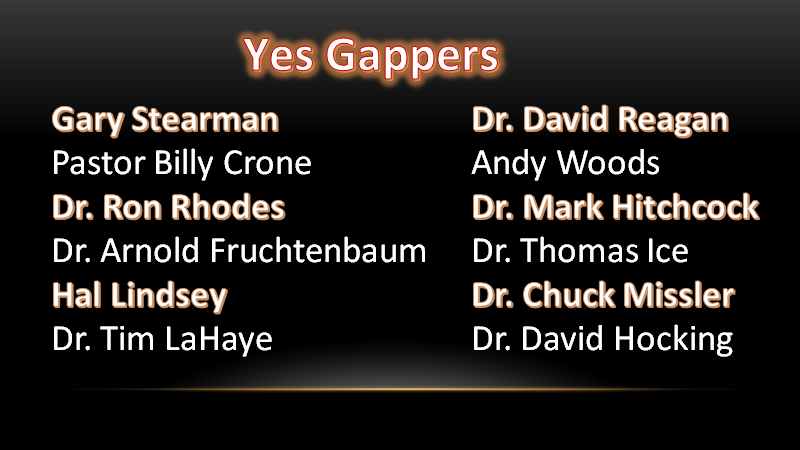The Jewish Wedding and the Post-Rapture / Pre-Tribulation Time Gap: Are They Compatible?
on Tuesday, July 30, 2019 by Bill Salus Recently, I received an email that questioned the existence of a time gap between the Rapture and the Tribulation Period. The emailer was concerned that there could be a conflict between the Jewish Wedding Model and the Post-Rapture / Pre-Tribulation Time Gap. For those unfamiliar with these two concepts, I have written about the Jewish Wedding Model in my book entitled, The NOW Prophecies and about the Post-Rapture / Pre-Tribulation (Pre-Trib) Time Gap in my book called, The NEXT Prophecies.
Recently, I received an email that questioned the existence of a time gap between the Rapture and the Tribulation Period. The emailer was concerned that there could be a conflict between the Jewish Wedding Model and the Post-Rapture / Pre-Tribulation Time Gap. For those unfamiliar with these two concepts, I have written about the Jewish Wedding Model in my book entitled, The NOW Prophecies and about the Post-Rapture / Pre-Tribulation (Pre-Trib) Time Gap in my book called, The NEXT Prophecies.
The Jewish Wedding Model
Since Jesus Christ was a Jew and the Church is considered to be His Bride, as per Revelation 19:7-9, Ephesians 5:22-33 and elsewhere, the Jewish Wedding Model is a great analogy to use as one of the arguments for a Pre-Tribulation Rapture. The traditional procedures for this wedding model are presented below.
1. Betrothal – The groom negotiated a fair price (mohair) for his bride. In the case of believers, the price was paid by Jesus Christ’s precious sacrificial blood upon the cross for the sins of believers.
2. Separation – The engagement period was actually a time of separation usually lasting about 12 months. While the bride-to-be stayed home, the groom returned to his father’s house to make preparations for their future lives together. This gave the bride time to prepare her trousseau, and the groom to construct a place for the two of them to live happily ever after. Presently, Christ and the bride are separated. He is in heaven while she is on earth preparing her wedding garments, which according to Revelation 19:8 are her righteous acts.
3. Preparation – The groom utilized the separation period to return to his father’s house to construct the couple’s new home on the premises. John 14:1-4 informs that Christ is preparing mansions in heaven for believers.
4. Fetching – At the appropriate time after the construction was completed, the groom came to fetch his bride. Although the bride knew the time would come, she didn’t necessarily know precisely when. This is the case with believers today; they know Christ is coming but don’t know the day or hour. Also, the groom’s arrival was usually accompanied by the best man and several friends. When the party arrived to fetch the bride there was often a shout from the friends to announce the groom had arrived. 1 Thessalonians 4:16 declares there will be a shout announcing Christ’s return from His friend the archangel.
5. Consummation – Once fetched, the two returned to the groom’s fathers house where they were secluded in a bridal chamber (huppah). While inside the chamber they consummated their marriage by entering into physical union for the first time. They remained secluded in the chamber, usually for about seven days, while the wedding guests enjoyed the wedding feast at the groom’s father’s house. This will be the similar case with Christ and his believers. Together they will be secluded somewhere in heaven consummating their union, while the seven-years of tribulation takes place on earth. The seven-days seem to represent these seven years of tribulation.
6. Celebration – After the seven days had elapsed, the groom brought his bride out of the chamber to greet the wedding guests and partake of the celebration. This will be the case after the Trib-Period, Christ will reign in His messianic kingdom and his bride will co-reign faithfully by His side.
The Post-Rapture / Pre-Tribulation Time Gap
Many of today’s top Bible prophecy experts acknowledge that a time-gap exists between the Rapture of the Church and the start of the seven-year Tribulation Period. This time-gap hypothesis is based upon the premise that it’s not the Rapture that triggers the start of the Tribulation Period, (Trib-Period), but it is the confirmation of a covenant by the Antichrist between Israel and some other party or parties that triggers the ticking of the Trib-Period. This covenant is identified primarily in Daniel 9:27 and Isaiah 28:15 and 18
The image below displays some of the respected Bible prophecy teachers that teach that there exists a Post-Rapture / Pre-Trib Time Gap.
The point of the matter is that unless the false covenant gets ratified at the exact moment that the Rapture occurs, then a time gap exists between these two events. Some, including me, believe this time interval could last for several years.
“Because you (Israel) have said, “We have made a covenant with death, And with Sheol we are in agreement. When the overflowing scourge passes through, It will not come to us, For we have made lies our refuge, And under falsehood we have hidden ourselves.”” (Isaiah 28:15; emphasis added)
Concerning the false covenant that triggers the start of the Trib-Period, Isaiah 28:15 points out that Israel becomes a signatory in order to avoid an overflowing scourge that is sweeping throughout the world. This overflowing scourge is being perpetrated by some entity represented by “Death and Sheol.” This hardly sounds like the Rapture becomes the cause for Israel to become a party to the false covenant.
Therefore it is safe to conclude the following:
1. It’s not the Rapture that prompts Israel to become a signatory to the false covenant,
2. Something terrible called, an “overflowing scourge,” is happening throughout the earth, sometime after the Pre-Trib Rapture occurs, that deeply concerns Israel,
3. The scourge necessitates the creation of the false covenant and prompts Israel to become a party to it,
4. A sequence of events results in the signing of the false covenant that starts the Trib-period. The chronology of events are:
a. The Rapture happens,
b. An overflowing scourge ensues in the aftermath,
c. The false covenant gets drafted,
d. Israel becomes a signatory of this covenant,
e. The Trib-Period begins.
The Jewish Wedding Model vs. the Post-Rapture / Pre-Trib Time Gap Theory
The concern of the emailer is quoted below.
“I have been puzzling out the post rapture gap for almost a year now! What it boils down to is the expectation that the Raptured Church is the Bride snatched away at an unknown moment to be married to her Bridegroom and then spends a traditional “wedding week” in celebration before coming back with Christ to bring an end at the time of Armageddon.
“Looking at the amount of time from two different perspectives, what’s going on in heaven and what’s going on here on Terra Firma, the gap makes perfect sense on earth, but I can’t reconcile it from an “in heaven” perspective.”
“My point for all this is the heavenly timeline. I see the “wedding feast” of seven – meaning seven years, and I see “forever.” But I am wondering if you might have some direction on other “heavenly” time groupings that might give us a clue about how long the saints will be with Christ before we return with him for the harvest? If we accept the idea of a post rapture – pre trib rapture than we have to reject the idea that there is only a “wedding week” for the raptured saints.”
The emailer poses a legitimate concern, but for the following reasons, it is not necessary to reject the Jewish Wedding Model in order to accept the Post-Rapture / Pre-Trib Time Gap.
1. The legal wedding ceremony preceded the “wedding week.”
2. The Bema Seat Judgment happens prior to the “wedding week.”
3. The heavenly “transition and training” period.
4. The Jewish Wedding Model is a “loose fit.”
1. The legal wedding ceremony preceded the “wedding week”
It’s important to note that the traditional Jewish Wedding included a ceremony between the “fetching” and the “consummation” events. Prior to entering the seclusion of the wedding chamber to consummate their marriage, the Groom and Bride participated in the following legal and ceremonial events.
a. The Witnesses: “Every legal procedure in Jewish life is confirmed by at least two “kosher” witnesses. These witnesses can under no circumstances be of the immediate family or even distant relatives to the participating parties. All Jewish documents must bear the signatures of two kosher witnesses.”
b. The Marriage Contract: To separate the betrothal blessings from the marriage blessings, a “Kesubah” (marriage contract) is read aloud as the binding document that details the husband’s obligations to his wife.
c. The Seven Blessings: At the conclusion of this initial part of the wedding ceremony, seven blessings were recited in the presence of a quorum of at least ten men, because of the communal emphasis of the blessings.
d. Breaking of the Wedding Glass: At the conclusion of the pronouncement of the seven blessings, the couple drinks from a ceremonial cup that the groom breaks with his right foot. This is done to commemorate the destruction of the Holy Temple in Jerusalem. The breaking of the glass symbolizes the breaking of their hearts in remembrance of this historic event.
After these above events took place, the seven days (wedding week) of seclusion followed. Below is a quote explaining this scenario.
“After the ceremony the bride and groom adjourn to a private room for a symbolic “consummation” of the marriage. This procedure is witnessed by the same two exclusive witnesses who were designated at the time when the ring was placed on the Kallah’s finger under the chuppah. The few minutes the couple share together allude to their new intimate relationship and emphasizes that their absolute privacy be respected. Refreshments are served, and the Choson and Kallah break their fast. Before entering the “Yichud” (private) room, a silver spoon is placed at the threshold. Both the groom and bride step over the spoon with their right foot first upon entering the room.”
2. The Bema Seat Judgment happens prior to the “wedding week”
The legal wedding ceremony above illustrates that there are preceding events that take place prior to the commencement of the “wedding week.” These events required that the Groom and Bride both be present together as participants.
In the case of the Church, the same holds true. There exists a necessary and important ceremonial event for the Bride called, “The Bema Seat Judgment.” The passages below identify this process and point out that it is a reward ceremony for each individual believer.
“But why do you, (believer), judge your (believing) brother? Or why do you show contempt for your brother? For we shall all stand before the judgment seat of Christ.” (Romans 14:10; emphasis added)
“For we are God’s fellow workers; you are God’s field, you are God’s building. According to the grace of God which was given to me, as a wise master builder I have laid the foundation, and another builds on it. But let each one take heed how he builds on it. For no other foundation can anyone lay than that which is laid, which is Jesus Christ. Now if anyone builds on this foundation with gold, silver, precious stones, wood, hay, straw, each one’s work will become clear; for the Day will declare it, because it will be revealed by fire; and the fire will test each one’s work, of what sort it is. If anyone’s work which he has built on it endures, he will receive a reward. If anyone’s work is burned, he will suffer loss; but he himself will be saved, yet so as through fire.” (1 Corinthians 3:9-15)
“Therefore we make it our aim, whether present or absent, to be well pleasing to Him. For we must all appear before the judgment seat of Christ, that each one may receive the things done in the body, according to what he has done, whether good or bad.” (2 Corinthians 5:9-10)
This Bema Seat Judgment, i.e. “the judgment seat of Christ,” appears to happen prior to the Trib-Period. This is understood from some of the details provided in Revelation chapters 4 and 5. These two chapters picture the Church in heaven represented by the “Twenty-Four Elders.” Revelation 5:8-10 informs that these elders are redeemed by the blood of Christ out of every tribe and tongue and people and nation.
In Revelation 4:11 there’s a lot of praising going on by the elders in the presence of the angels. One of the reasons for this appears to be because they have previously experienced their rewards ceremony at the judgment seat of Christ. In Revelation 4:4 the elders are sitting on thrones wearing white robes and hosting crowns of gold upon their heads. When did they get these thrones, garments and crowns, if not from their “judgment seat of Christ” rewards ceremony? In Rev. 4:10, the elders are worshipping God and casting their crowns before His throne.
Then, in Revelation 5 we are told that the twenty-four elders are eyewitnesses to watching Jesus Christ receive the heavenly scroll that contains the Seal, Trumpet and Bowl Judgments. These are the judgments that take place after the Rapture and throughout the Trib-Period.
“Now when He, (The resurrected Jesus Christ), had taken the scroll, the four living creatures and the twenty-four elders fell down before the Lamb, each having a harp, and golden bowls full of incense, which are the prayers of the saints. And they sang a new song, saying: “You are worthy to take the scroll, And to open its seals; For You were slain, And have redeemed us (believers) to God by Your blood (after the crucifixion) Out of every tribe and tongue and people and nation, And have made us kings and priests to our God; And we shall reign on the earth.”” (Rev. 5:8-10; emphasis added)
This passage points out that the believers not only have previously been rewarded with thrones, garments and crowns, but also have received harps and been elevated to the ranks of kings and priests. All of this has also happened prior to the Trib-Period. The description reads, “And have made us kings and priests.” This is written in the past tense, meaning that by the time Christ receives the scroll, it has already happened. It doesn’t say, “And will make us kings and priests,” in the future.
Thus, prior to the commencement of the Trib-Period, which occurs on or around when the contents of the heavenly scroll are opened, the believers have already transitioned from earthly life, been rewarded at the judgment seat of Christ and been trained to serve as kings and priests for the purposes of their “reign on the earth.” As kings, we will co-reign with Christ during the Millennium. This is also a point picked up in 2 Timothy 2:12.
3. The heavenly “transition and training” period
Have you ever floated upon a cloud, traveled at the speed of thought, played a harp, or been a king or a priest? If not, there is likely a transition and training period that must take place for each believer. It could be as practical as comparing the transition from the womb to the world and the growth process that follows.
Before the infant can run, it must crawl, stand and walk. Before the doctor can conduct a surgery, he or she must go through med-school and internship. Perhaps some training may be required for the believer after the Rapture to enable him or her to function as a king or priest? From the clues in Revelation chapters 4 and 5, it appears as though believers go through some transitioning, rewarding and training, prior to going into the wedding week to consummate the marriage.
The question is how long will it take for billions of believers to go through this three-fold process? It’s my guess that while the overflowing scourge is being perpetrated upon the earth, that believers will be getting rewarded and prepped, up in heaven.
4. The Jewish Wedding Model is a “loose fit.”
When it comes to the Jewish Wedding Model, it is a good analogy to use as an argument for a Pre-Trib Rapture, but it falls short as a nullification for the time gap. Traditionally, the “separation and preparation” stages of the Jewish Wedding last for about one-year, but Christ has been separated from His Bride the Church for nearly 2000 years.
“For a thousand years in Your sight Are like yesterday when it is past, And like a watch in the night.” (Psalm 90:4)
“But, beloved, do not forget this one thing, that with the Lord one day is as a thousand years, and a thousand years as one day. The Lord is not slack concerning His promise, as some count slackness, but is longsuffering toward us, not willing that any should perish but that all should come to repentance.” (2 Peter 3:8-9)
One might argue that these two verses above inform that a day to the Lord is as a 1000 years. This is correct, so in this scenario the “separation and preparation” process has been ongoing for about two (God) years, rather than the usual one-year period. During these two (God) years the Lord has not been slacking in “His promise,” but He has been “longsuffering toward us, not willing that any should perish but that all should come to repentance.”
It appears as though the wedding week could last throughout the seven years of Tribulation, but only our long-suffering God knows for sure.



